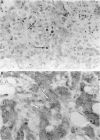Abstract
BACKGROUND: Apoptosis has a role in many cellular processes including development, normal tissue homeostasis, and malignancy. This aspect of research is relatively new with distinct methods of analysing disparate biochemical and genetic events to measure apoptotic cells. The use of biotinylated nucleotides to identify DNA strand breaks is a commonly reported method of estimating cells numbers undergoing apoptosis; however, investigators report inconsistent results for a variety of reasons. AIMS AND METHOD: To compare two in situ techniques of measuring apoptosis: in situ nick translation (ISNT) and TdT mediated dUTP-biotin nick end labelling (TUNEL); and to assess DNA cleavage in 20 paired paraffin wax embedded breast cancer tissues from patients; one group who had received no prior treatment and one group who had received chemohormonal treatment. RESULTS AND CONCLUSIONS: Apoptotic scores obtained from paraffin wax embedded human breast cancer after using ISNT and TUNEL methods were not significantly different (p = 0.11). A strong correlation between scores obtained from the two techniques was found (r = 0.758, p < 0.0001). Optimisation of both techniques is crucial to ensure maximal assay performance in breast cancer tissue.
Full text
PDF



Images in this article
Selected References
These references are in PubMed. This may not be the complete list of references from this article.
- Davison F. D., Groves M., Scaravilli F. The effects of formalin fixation on the detection of apoptosis in human brain by in situ end-labelling of DNA. Histochem J. 1995 Dec;27(12):983–988. [PubMed] [Google Scholar]
- Dive C., Evans C. A., Whetton A. D. Induction of apoptosis--new targets for cancer chemotherapy. Semin Cancer Biol. 1992 Dec;3(6):417–427. [PubMed] [Google Scholar]
- Ellis P. A., Smith I. E., McCarthy K., Detre S., Salter J., Dowsett M. Preoperative chemotherapy induces apoptosis in early breast cancer. Lancet. 1997 Mar 22;349(9055):849–849. doi: 10.1016/s0140-6736(05)61752-7. [DOI] [PubMed] [Google Scholar]
- Gavrieli Y., Sherman Y., Ben-Sasson S. A. Identification of programmed cell death in situ via specific labeling of nuclear DNA fragmentation. J Cell Biol. 1992 Nov;119(3):493–501. doi: 10.1083/jcb.119.3.493. [DOI] [PMC free article] [PubMed] [Google Scholar]
- Gorczyca W., Gong J., Darzynkiewicz Z. Detection of DNA strand breaks in individual apoptotic cells by the in situ terminal deoxynucleotidyl transferase and nick translation assays. Cancer Res. 1993 Apr 15;53(8):1945–1951. [PubMed] [Google Scholar]
- Kerr J. F., Wyllie A. H., Currie A. R. Apoptosis: a basic biological phenomenon with wide-ranging implications in tissue kinetics. Br J Cancer. 1972 Aug;26(4):239–257. doi: 10.1038/bjc.1972.33. [DOI] [PMC free article] [PubMed] [Google Scholar]
- Lucassen P. J., Chung W. C., Vermeulen J. P., Van Lookeren Campagne M., Van Dierendonck J. H., Swaab D. F. Microwave-enhanced in situ end-labeling of fragmented DNA: parametric studies in relation to postmortem delay and fixation of rat and human brain. J Histochem Cytochem. 1995 Nov;43(11):1163–1171. doi: 10.1177/43.11.7560899. [DOI] [PubMed] [Google Scholar]
- Mundle S. D., Gao X. Z., Khan S., Gregory S. A., Preisler H. D., Raza A. Two in situ labeling techniques reveal different patterns of DNA fragmentation during spontaneous apoptosis in vivo and induced apoptosis in vitro. Anticancer Res. 1995 Sep-Oct;15(5B):1895–1904. [PubMed] [Google Scholar]
- Oberhammer F., Wilson J. W., Dive C., Morris I. D., Hickman J. A., Wakeling A. E., Walker P. R., Sikorska M. Apoptotic death in epithelial cells: cleavage of DNA to 300 and/or 50 kb fragments prior to or in the absence of internucleosomal fragmentation. EMBO J. 1993 Sep;12(9):3679–3684. doi: 10.1002/j.1460-2075.1993.tb06042.x. [DOI] [PMC free article] [PubMed] [Google Scholar]
- Panchalingam S., Reynolds G. M., Lammas D. A., Rowlands D. C., Kumararatne D. S. Simple method for pretreatment of tissue sections for the detection of apoptosis by in situ end-labelling and in situ nick translation. Clin Mol Pathol. 1996 Oct;49(5):M273–M277. doi: 10.1136/mp.49.5.m273. [DOI] [PMC free article] [PubMed] [Google Scholar]
- Powles T. J., Hickish T. F., Makris A., Ashley S. E., O'Brien M. E., Tidy V. A., Casey S., Nash A. G., Sacks N., Cosgrove D. Randomized trial of chemoendocrine therapy started before or after surgery for treatment of primary breast cancer. J Clin Oncol. 1995 Mar;13(3):547–552. doi: 10.1200/JCO.1995.13.3.547. [DOI] [PubMed] [Google Scholar]
- Sträter J., Günthert A. R., Brüderlein S., Möller P. Microwave irradiation of paraffin-embedded tissue sensitizes the TUNEL method for in situ detection of apoptotic cells. Histochem Cell Biol. 1995 Feb;103(2):157–160. doi: 10.1007/BF01454013. [DOI] [PubMed] [Google Scholar]
- Wijsman J. H., Jonker R. R., Keijzer R., van de Velde C. J., Cornelisse C. J., van Dierendonck J. H. A new method to detect apoptosis in paraffin sections: in situ end-labeling of fragmented DNA. J Histochem Cytochem. 1993 Jan;41(1):7–12. doi: 10.1177/41.1.7678025. [DOI] [PubMed] [Google Scholar]
- Wyllie A. H. Apoptosis and the regulation of cell numbers in normal and neoplastic tissues: an overview. Cancer Metastasis Rev. 1992 Sep;11(2):95–103. doi: 10.1007/BF00048057. [DOI] [PubMed] [Google Scholar]
- Wyllie A. H. Glucocorticoid-induced thymocyte apoptosis is associated with endogenous endonuclease activation. Nature. 1980 Apr 10;284(5756):555–556. doi: 10.1038/284555a0. [DOI] [PubMed] [Google Scholar]
- Wyllie A. H., Kerr J. F., Currie A. R. Cell death: the significance of apoptosis. Int Rev Cytol. 1980;68:251–306. doi: 10.1016/s0074-7696(08)62312-8. [DOI] [PubMed] [Google Scholar]



